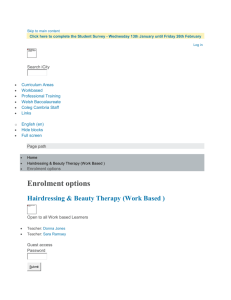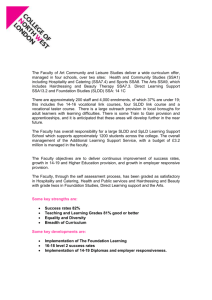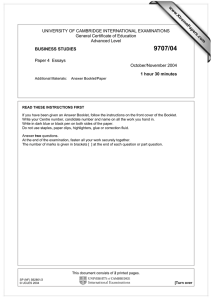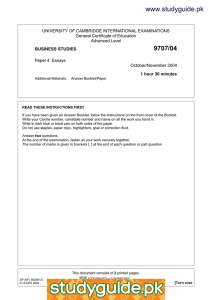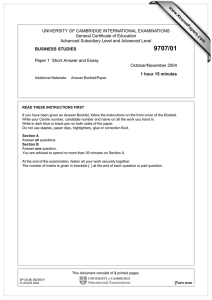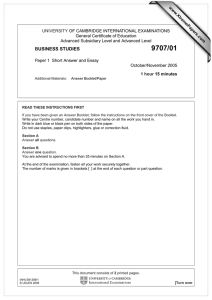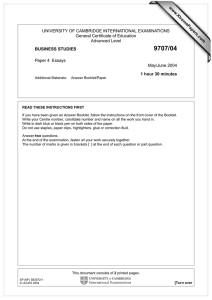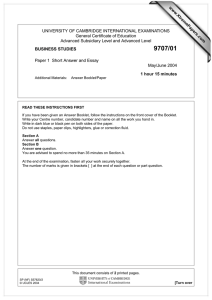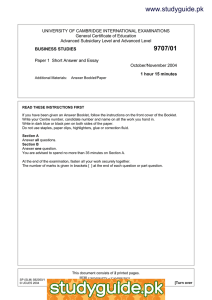www.XtremePapers.com UNIVERSITY OF CAMBRIDGE INTERNATIONAL EXAMINATIONS General Certificate of Education Advanced Level 9707/32
advertisement
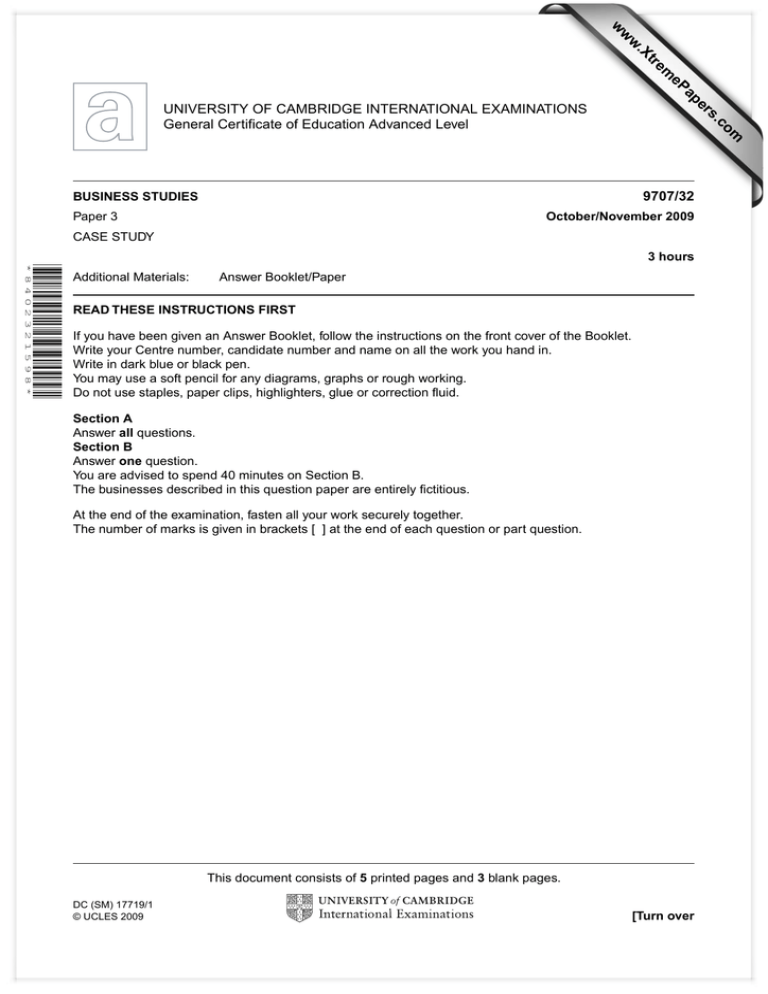
w w ap eP m e tr .X w om .c s er UNIVERSITY OF CAMBRIDGE INTERNATIONAL EXAMINATIONS General Certificate of Education Advanced Level 9707/32 BUSINESS STUDIES Paper 3 October/November 2009 CASE STUDY 3 hours *8402321598* Additional Materials: Answer Booklet/Paper READ THESE INSTRUCTIONS FIRST If you have been given an Answer Booklet, follow the instructions on the front cover of the Booklet. Write your Centre number, candidate number and name on all the work you hand in. Write in dark blue or black pen. You may use a soft pencil for any diagrams, graphs or rough working. Do not use staples, paper clips, highlighters, glue or correction fluid. Section A Answer all questions. Section B Answer one question. You are advised to spend 40 minutes on Section B. The businesses described in this question paper are entirely fictitious. At the end of the examination, fasten all your work securely together. The number of marks is given in brackets [ ] at the end of each question or part question. This document consists of 5 printed pages and 3 blank pages. DC (SM) 17719/1 © UCLES 2009 [Turn over 2 CHAN BEAUTY COMPANY (CBC) June Chan’s beauty business June had always been ambitious and self motivated but she never imagined her business empire would be so successful. After completing a hairdressing course at college she used all of her savings and a bank loan to start her own business, CBC, 5 providing hairdressing for women. June worked 13 hours a day and took no holiday for a year and within 12 months she was able to repay the bank loan. She had even saved up enough to put a deposit on another hairdressing shop that was for sale. After three years, June was the main shareholder in a private limited company operating three hairdressing shops in different towns and two ‘fitness and beauty’ centres that offered keep fit classes as well as beauty treatments. She now looked 10 around for new challenges. Ethical beauty products One idea that June wanted to develop was to create a range of ethical beauty products for both men and women. She made small batches of creams, soaps and shampoos and they were very successful in one of the hairdressing shops in the town of Urbis. Average customer incomes were high in this town and customers seemed prepared to pay high prices for socially responsible products. June wanted to manufacture these products on a much larger scale. The products would not be tested on animals and would contain only natural ingredients such as cocoa butter and nut oils. These would be purchased from small, local suppliers who would receive prices above the market average to encourage long term sustainable development. Meeting Jon Kiplagat was a big step in June’s life. He was a rich businessman who had used much of his wealth to support charities. He offered to help finance a factory to produce June’s ethical beauty products in exchange for a 45% stake in CBC. He explained that he was not interested in managing the factory, short term profits were not a priority and June would have complete control. Within 4 months: • Premises had been found and fitted with large scale batch production equipment • The first products had been made • Some large retail customers had been signed up on short term contracts. 15 20 25 30 Poor communication The products proved to be popular but not very profitable because of production and supply problems. June had no experience of managing a factory. She left the running of it to a senior supervisor but problems soon became apparent. Suppliers 35 complained of receiving confusing orders. Retail customers could not get enough stock of the most popular ranges, but their telephone calls for more deliveries went unanswered. Different departments of the factory appeared not to be communicating with each other. The factory workforce had agreed to work flexibly, switching from one task to another. Workers were paid a good salary but they did not like the formal 40 instructions pinned to the notice-board each morning giving details of the daily jobs with no thought given to their preferred work groups. Initial production problems had often gone unsolved as the staff had not been consulted about the most likely causes. 45 The business now CBC is made up of the three original hairdressing shops, the factory and eight fitness and beauty centres. June’s leadership style as Managing Director is not autocratic as she is keen to see managers develop. She concentrates on developing new ideas for company expansion as she finds this much more exciting than day-to-day routine details. At present, June is considering two strategies for the 50 growth of the company. © UCLES 2009 9707/32/O/N/09 3 Option 1: Market development – selling ethical beauty products in other countries. This would involve exporting the beauty products to Country X. June is keen on this idea – she wants to run an international business empire! The Marketing Director warned, however, that: ‘Consumer tastes may be very different and does it have the same youthful population profile as our own country? We would also need to consider the impact that the appreciation of our currency’s exchange rate would have.’ June had estimated some investment appraisal results for this strategy – see Appendix A. Option 2: Diversification – selling a range of clothing. June believes that consumers are starting to reject cheap clothes made in factories with low wage workers who are often still children. ‘If we sold a range of clothing to complement our beauty products we could use the term “ethically produced clothes” as a useful marketing weapon’ the Marketing Director said to June. ‘I am sure that we would not need to do much market research as we know our hair and beauty customers so well any way. I have done some quick calculations of potential future cash flows from this strategy.’ He presented the following net cash flow forecasts to June for Option 2: Year 0 (capital cost) Year 1 Year 2 Year 3 Year 4 ($6m) $2m $3m $6m $4m Future issues June’s satisfaction over the success of her business was shattered by the news of Jon Kiplagat’s death. He had left shares in all of his business interests to his son, Jim. Jim puts profit as his main objective. He is very keen to get involved in helping to manage the company. June wondered how to keep control of the company especially as it might be necessary to sell more shares privately to raise finance for the new growth strategy. At around the same time, the Business News carried two significant reports. One was about the slower rate of economic growth and the other gave details of new foreign competitors in the beauty product market. 9707/32/O/N/09 60 65 70 Cityville hairdressing shop – should we close this? At a recent CBC Board of Directors meeting, June was disappointed to see the financial performance of the original hairdressing shops. She admitted to herself that she had ignored this side of the company in recent years and now the Finance Director showed her the data in Appendix B. ‘It seems obvious to me that we should shut down Cityville hairdressers,’ June said. ‘This will increase the overall profitability of the company and free up funds for investment in my new ideas.’ ‘But,’ replied the Finance Director, ‘it would be a financial mistake to shut this Cityville shop now and do not forget that three of the employees there have been working for you for several years.’ © UCLES 2009 55 75 80 85 [Turn over 4 Appendix A: Estimated investment appraisal data for Option 1: Market Development Average Rate of Return over 4 years 26.7% Net Present Value @ 10% discount rate $4.25m Payback period 2 years Initial capital costs $4m Appendix B: Data for the three hairdressing shops. Year ending 31/10/09 Newtown Cityville Urbis 6 500 4 800 9 500 $12 $8 $16 Total variable costs $25 000 $12 000 $28 000 Fixed costs of shop $10 000 $9 000 $16 000 Allocated share of Head Office overheads $22 000 $28 000 $30 000 Labour turnover 10% 33% 8% % of customers who complained 1% 8% 3% Change in unemployment rate over last 12 months in each town +2% –3% –1% Number of customers Average price per customer Table 1: 10% discount factors © UCLES 2009 Year 0 Year 1 Year 2 Year 3 Year 4 1 0.91 0.83 0.75 0.68 9707/32/O/N/09 5 Section A Answer all questions in this section. 1 (a) Analyse two possible reasons for the communication problems in the factory. [8] (b) Evaluate two ways in which communication might be improved in the factory. [10] 2 Using the data in Appendix B, calculate the impact on the company’s annual profit of closing the Cityville hairdressing shop. [8] 3 Recommend what CBC should do with the Cityville hairdressing shop. Fully support your recommendation. [14] 4 (a) Calculate for Option 2 the: (i) Average Rate of Return (ARR) [4] (ii) Net Present Value (NPV) using the10% discount factors in Table 1. [4] (b) Which of the two options would you advise June to choose? Fully support your answer by referring to your results from 4(a) and other information. [16] 5 Assume Option 1, the market development option, is chosen. Discuss the important features of a marketing plan for a successful launch in your country of the ethical beauty products. [16] Section B Answer one question in this section. 6 Discuss whether the future success of the company will depend more on June’s management skills or on external factors outside of the company’s control. [20] 7 To what extent should it be a priority for this business to meet the needs of stakeholders other than shareholders? [20] © UCLES 2009 9707/32/O/N/09 6 BLANK PAGE 9707/32/O/N/09 7 BLANK PAGE 9707/32/O/N/09 8 BLANK PAGE Permission to reproduce items where third-party owned material protected by copyright is included has been sought and cleared where possible. Every reasonable effort has been made by the publisher (UCLES) to trace copyright holders, but if any items requiring clearance have unwittingly been included, the publisher will be pleased to make amends at the earliest possible opportunity. University of Cambridge International Examinations is part of the Cambridge Assessment Group. Cambridge Assessment is the brand name of University of Cambridge Local Examinations Syndicate (UCLES), which is itself a department of the University of Cambridge. 9707/32/O/N/09
